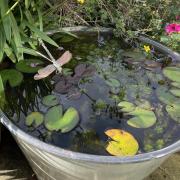Last week I was in the Isles of Scilly and returned with many new ideas to try out at my new design project in Paul. I really love how ornamentals such as Geranium madarense and Echium candicans have harmoniously naturalised amongst UK natives - though slightly concerned how much the Muehlenbeckia is invading the rocky coastline.
A blend of exotic and indigenous plants will be the mainstay of my Paul scheme. The owner has an existing Phoenix canariensis and a few Dicksonia antarctica, so the structure is already there. To be on the safe side of hardiness, I will plant Echium pininana instead of candicans but willing to give the Geranium a go. The underplanting will be native ferns: Athyrium filix-femina, Polypodium vulgare (if only I could get hold of the Cornish polypody) and Polystichum setiferum.
That should make a lovely scheme reminiscent of my trip without the use of any Muehlenbeckia.

What to do this month
What with our early Cornish springs, the wild meadow grasses romp away and can start to look like a mess in June. We must resist the urge to cut it too early. If you look closely, many of the later flowering bulbs, for example bluebells, are not even dormant yet. Also, many ground nesting birds need this cover until July.
It’s best to wait until the end of July when all the wildflower seeds have dispersed, and fauna has vacated. Don’t forget to leave the mowings for a few days to wilt and then rake up and dispose as we don’t want decaying grass to feed the sward – the idea is to impoverish the soil so that wildflowers can compete against the potentially rank grasses. I actually make hay with some for the chicken’s nest boxes and use the rest as mulch around trees.
If your sward is all grass and no wildflowers, order some yellow rattle seed or plugs (Rhinanthus major) for this autumn. Rattle is semi-parasitic on grasses and will successfully weaken them, allowing for wildflowers to gain advantage.

If you only do one thing
Tomatoes, aubergine and peppers will all need weekly feeding now as they set fruit. They are remarkably greedy. I use a weak mix (one cap per can of Maxicrop tomato feed with seaweed.

Plant of the month
Romneya coulteri will begin to flower now and carry on for months. Its glaucous foliage and poppy flower is harmonious with most schemes. I plant it at the base of walls at the back of the border as a kind of hollyhock alternative. Once established (which can be tricky), it is indestructible.



























